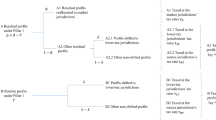Abstract
We consider the impact of taxation when investors face a discrete choice between two or more mutually exclusive projects; in particular we consider the location choice of multinationals. Such choices depend on an effective average tax rate. We propose a precise measure of this rate, which is shown to be equal to a weighted average of an effective marginal tax rate and an adjusted statutory tax rate, where the weights depend on the profitability of the investment. Estimates of the distribution of this measure are presented and compared for domestic and international investment in the USA, France, Germany and the UK. We analyse the impact of harmonising corporate tax rates in Europe on incentives to locate in France, Germany and the UK.
Similar content being viewed by others
References
Alworth, J. (1988). The Finance, Investment and Taxation Decision of Multinationals. New York: Basil Blackwell.
Auerbach, A. J. (1979). “Wealth Maximization and the Cost of Capital.” Quarterly Journal of Economics 21, 107-127.
Caves, R. (1996). Multinational Enterprise and Economic Analysis, 2nd ed., Cambridge: Cambridge University Press.
Chennells, L. and R. Griffith. (1997). Taxing Profits in a Changing World. Institute for Fiscal Studies.
Collins, J. H. and D. A. Shackelford. (1995). “Corporate Domicile and Average Effective Tax Rates: The Cases of Canada, Japan, the UK and USA.” International Tax and Public Finance 2, 55-83.
Devereux, M. P. and R. Griffith. (1998a). “Taxes and the Location of Production: Evidence from a Panel of US Multinationals.” Journal of Public Economics 68(3), 335-367.
Devereux, M. P. and R. Griffith. (1998b). “The Taxation of Discrete Investment Choices.” Working Paper 98/16, Institute for Fiscal Studies.
Devereux, M. P., L. Lammersen and C. Spengel. (2000). “The Effective Levels of Company Taxation in the Member States of the EU.” Institute for Fiscal Studies.
Devereux, M. P. and M. Pearson. (1995). “European Tax Harmonisation and Production Efficiency.” European Economic Review 39, 1657-1681.
Dunning, J. H. (1977). “Trade, Location of Economic Activity and MNE: A Search for an Eclectic Approach.” In B. Ohlin, P. O. Hesselborn and P. M. Wijkman (eds.), The International Allocation of Economic Activity. London: Macmillan, 395-418.
Dunning, J. H. (1981). International Production and the Multinational Enterprise. London: George Allen and Unwin.
Edwards, J. S. S. and M. J. Keen. (1984). “Wealth Maximization and the Cost of Capital: A Comment.” Quarterly Journal of Economics XCVIII, 211-214.
European Commission. (2001). Company Taxation in the Internal Market. Brussels: European Commission.
Fullerton, D. (1984). “Which Effective Tax Rate?” National Tax Journal 37, 23-41.
Hall, R. E. and D. Jorgensen. (1967). “Tax Policy and Investment Behavior.” American Economic Review 57, 391-414.
Hartman, D. G. (1985). “Tax Policy and Foreign Direct Investment.” Journal of Public Economics 26, 107-121.
Horstmann, I. and J. Markusen. (1992). “Endogenous Market Structures in International Trade (natura facit saltum).” Journal of International Economics 32, 109-129.
Jorgensen, D. W. (1963). “Capital Theory and Investment Behaviour.” American Economic Review 53, 247-259.
Keen, M. J. (1991). “Corporation Tax, Foreign Direct Investment and the Single Market.” In L. A. Winters and A. J. Venables (eds.), The Impact of 1992 on European Trade and Industry. Cambridge: Cambridge University Press.
King, M. A. (1974). “Taxation, Investment and the Cost of Capital.” Review of Economic Studies 41, 21-35.
King, M. A. and D. Fullerton. (1984). The Taxation of Income from Capital. Chicago: University of Chicago Press.
Markusen, J. (1995). “The Boundaries of Multinational Enterprises and the Theory of International Trade.” Journal of Economic Perspectives 9(2), 169-189.
Mendoza, E. G., A. Razin and L. L. Tesar. (1994). “Effective Tax Rates in Macroeconomics: Cross-Country Estimates of Tax Rates on Factor Incomes and Consumption.” Journal of Monetary Economics, 34, 297-323.
OECD. (1991). Taxing Profits in a Global Economy. Paris: OECD.
Ruding Committee. (1992). Report of the Committee of Independent Experts on Company Taxation. Brussels: European Commission.
Swenson, D. (1994). “The Impact of US Tax Reform on Foreign Direct Investment in the United States.” Journal of Public Economics 54, 243-266.
Author information
Authors and Affiliations
Rights and permissions
About this article
Cite this article
Devereux, M.P., Griffith, R. Evaluating Tax Policy for Location Decisions. International Tax and Public Finance 10, 107–126 (2003). https://doi.org/10.1023/A:1023364421914
Issue Date:
DOI: https://doi.org/10.1023/A:1023364421914




